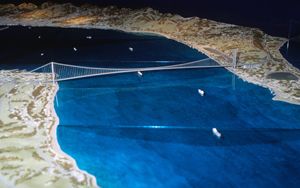(Finance) – A strategic infrastructural work, ready for construction immediately and a driving force for economic growth, assigned at the end of a long process of international race, which makes possible the creation of one of the largest metro systems of the Mediterranean, motivating both the development of the railway network in Sicily and the construction of the high-speed/high-capacity railway axis Salerno-Reggio Calabria-Messina-Palermo. This is what was underlined by the Engineering Director Webuild, Michele Longoduring a audition Member of Parliament at Joint Commissions VIII (Environment, territory and public works) and IX (Transport, post and telecommunications) regarding the construction of the stable connection between Sicily and Calabria.
“The Bridge over the Strait of Messina it is highly innovative and will be the longest suspended in the world, with a total length of 3,660m and a span of 3,300 metres,” he said. “The Eurolink consortium, which won the tender for its construction and of which Webuild is the leader, is made up of an international grouping of companies among the most qualified in the world in the design and construction of bridges. Webuild alone boasts a track record of bridges and viaducts built for 1,018 km in Italy and abroad, including the Second and Third Bosphorus Bridges in Turkey and the Genoa San Giorgio Bridge in Italy”.
“As soon as the addendum for the restoration of the contract has been signed, the project can start. The duration of the executive design is expected to be 8 months, while the time required for the construction of the bridge will be just over 6 years. Webuild, in quality as leader of the Eurolink Consortium, has the sole interest of carrying out the work and therefore places himself at the disposal of the country to start the works as soon as possible”, he added. “The amount relating to the construction of the bridge, as a single crossing work, is approx 4.5 billioncorresponding to approximately 40% of the total value of the infrastructural system which includes the bridge and all ancillary works”, he explained. “The remaining 60% is in fact related to a complex of works for connecting and strengthening the road network And railway on the Sicily and Calabria sides, and to a considerable number of interventions of redevelopment of the territory and mitigation of the hydrogeological risk”.
“The project – Longo underlined again – will have a strong economic impact And occupational on the territory, with an expected increase in the national GDP equal to 2.9 billion a yearequal to 0.17% of the national GDP, and with the involvement of approx 300 suppliers, especially small and medium-sized enterprises in the area. They are also expected beyond 100,000 potentially employable people during the life of the project, including the associated activities generated, with personnel mainly employed in regions such as Sicily And Calabria, with high unemployment rate.
“The bridge as designed is stable and safe – concluded Longo -. The aerodynamic stability of the deck is guaranteed for winds of up to 300 km/h, with unrestricted traffic on the bridge up to winds of 150 km/h. For aspects related to seismic checks, the bridge has a requirement of structural integrity compatible with an earthquake of magnitude 7.5 Richter, higher than the Messina earthquake of 1908″.
Meanwhile since Ministry of Infrastructure at the end of the cycle of hearings that took place in the Chamber on the decree on the bridge, they leaked that the construction of the bridge over the Strait of Messina “is a challenge that Deputy Prime Minister and Minister Matteo Salvini intends to overcome, after decades of studies and debates”, expressing “great satisfaction for the reassurances on the quality of the project, on the benefits of the work on the territory, on the determination of the Regions” that emerged during the hearings.
